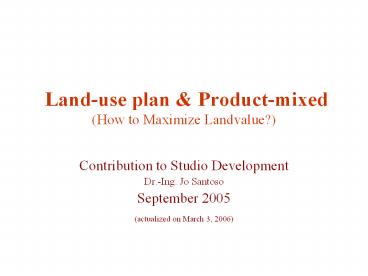Land-use plan PowerPoint PPT Presentation
1 / 24
Title: Land-use plan
1
Land-use plan Product-mixed(How to Maximize
Landvalue?)
- Contribution to Studio Development
- Dr.-Ing. Jo Santoso
- September 2005
- (actualized on March 3, 2006)
2
Landuse-plan, Landvalue-plan Product-mixed
- Land-use plan divided the site in saleable and
non saleable are. - Saleable area is divided in high-value,
middle-value and low-value area. - Non-saleable area is divided in Infrastructure,
Social Facilities, Green and other restricted
Zone.
3
Landuse-plan, Landvalue-plan Product-mixed
- Land-use plan is composed to maximize land value.
- The landvalue-plan is the basic to allocate the
proposed product-mixed. - Land-use plan is the basic to establish
development plan
4
Key Factors Determining Development Concept
- External Determinants (uncontrollable)
Government Policy Regulation, Economic
Condition, Natural Condition, Externalities,
Demand, etc. - Internal Determinants (controllable) Financial
Condition, Human Resources, Corporate Culture,
Design, Technical System, etc.
5
External and Internal Key-factors
- External factors uncontrollable but some can
be modified, some others change it self by the
time. - Developer should try to increase positive impacts
and to reduce negative impacts of external
factors. - Identification of most possible external
condition as point of departure - Land-use plan in particular or design in general
is the most important internal key factor to
maximize added value. - Land-value plan is the base to design land-use
plan.
6
Where is the added value coming from?
- How to mixed the products?
- How to put which product on the right place/site?
- Which product is to sell first, which is second,
etc. - Which facilities should be built, where and when?
- Which level of services should be provided to
support the development?
7
How to mixed the products?
- How to estimate the quantity and the composition
of the products? - How to select the right locations for the
products? - Method Elaborate different possibilities through
alternative Land-use plans.
8
(No Transcript)
9
Development Scenario (1)
- Qualitative Survey is needed to identify most
possible external condition - Strategy to face worst condition or to utilize
best condition of externalities. - Increasing of land-price is projected base on
most possible external condition.
10
Development Scenario (2)
- The land-use plan is designed with most possible
external condition as point of departure. - The flexibility of landuse-plan is an important
factor to anticipate changing of externalities.
11
Development Scenario (3)
- The best development scenario is base on balance
between profit and risk. - Profit can be increase by maximizing internal,
controllable key factors and optimizing of
external uncontrollable condition.
12
Strategy to Anticipate Changing of External
(uncontrollable) Condition
- Anticipate the changing of Government Policy
Regulation. - Anticipating strategy to face changing of
economic condition. - Technical Risk Assessment to anticipate the
changing of natural condition. - Observation the changing of all important
external factors. - Provide Flexibility in technical and corporate
planning
13
Optimizing Controllable (internal) Condition to
maximize profit
- Solid Financial Condition
- Good quality of Human Resources innovative,
creative - Strong Corporate Culture
- Reliable Technical System, etc.
- Flexible Design
14
Relation of Saleable and Non- saleable Area
- There is a strong relationship between saleable
area (areas/lots to sell or to rent) and
non-saleable area (areas to built infrastructure,
utilities and facilities) indicated with the
increasing of landprice. - How to estimate the right proportion between
saleable and non saleable - How to select the appropriate facilities
- How to chose the right time to built the
facilities? Which should be there in the
beginning of the development, which should follow?
15
The Right Proportion
- Is needed between
- Lots and ROW
- Commercial and social facilities
- Greens and built up area
- High, Middle and Low value
16
Phasing
Terms High-value Middle-value Low-value No-Value
Short
Middle
Long
Flexible
17
Development Phase
Laboratorium for Urban Planning of Tarumanagara
University
18
Table of Land-valueplan
Location Land- use Area (sqm) Effective Non- Effective
Saleable (gross) Subtotal saleable Net-saleable
Non-Saleable Subtotal non saleable
Total Total dev area Subtotal Eff. area Subtotal non-eff area
19
Table of Land-use plan
Gross Area Function Phase 1 (ha) Phase 2 (ha) Phase 3 (ha) SubTotal (ha)
Saleable Area Housing Commercial Others
Non-Saleable Infrastruktur Facilities Greens Others
Reserve
Subtot Subtot Subtot Total
20
Prediction of Land Price
Year 1 Year 2 Year 3 Year 4 Year 5 etc.
Housing H 1 H 2 H 3 Area sold Preis
Commercial C1 C2 C3
Laboratorium for Urban Planning of Tarumanagara
University
21
Land-price Assumption
Land price/ sqm
preparation
growth
mature
assumption of land price increase, based on
optimistic and pessimistic case
Laboratorium for Urban Planning of Tarumanagara
University
22
Study, Physical Planning Design
- (a)Landuse-plan
- gtdistribution of development area in
different functions/effective non-effective
area. - (b) Land value-plan
- gtdivision the area in high-middle-low and no
values of land/saleable non-saleable area. - (c)Development phases/stages
- gt determines the timing of construction and of
the product delivery - gt determines the development stages
- (d) Other studies (marketstudy, environmental
study,etc.)
23
The Process (Housing Project)
Owners Input from Market Analysis (Product
Mixed/ Land-valueplan)
Owners Input (Development Framework)
Owners Input from Investment Analysis (Pre-FS)
Discussion
Study on existing conditions of
Location (technical, social-cultural,etc)
Land-use Plan Development Scenario
DRAFT FINAL Of Development Concept
Final Development Concept
ALTERNATIVE ZONING PLAN
Consultation
Governments Requirements and Regulation
Comments from Authority
Inputs from Engineering Study
STAGE 1
STAGE 2
STAGE 3
STAGE 4
Laboratorium for Urban Planning of Tarumanagara
University
24
Development Phase
Laboratorium for Urban Planning of Tarumanagara
University

